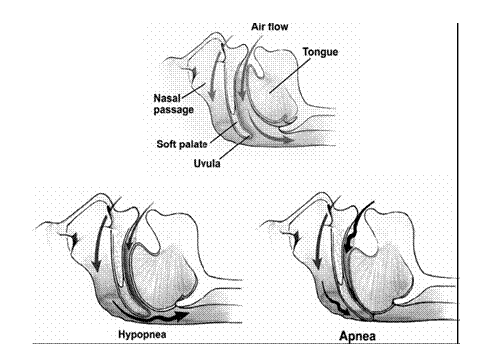|
TT Sleep |
|
Sleep Smart |



|
What is Obstructive Sleep Apnea ? |
Sleep apnea
Sleep apnea occurs when the upper airway (the area between the palate and the voice box ) partially or fully closes during sleep. Airflow stops or decreases, but the effort to breathe continues.
The body, sensing an increase in airway resistance, arouses out of sleep gasping for air. It is this recurrent arousal out of sleep, which fragments sleep, and produces daytime sleepiness.
Stress on the nervous system produced by the obstructed airway causes or aggravates hypertension.
The low oxygen levels resulting from an obstructed airway increase heart attack and stroke risk. |
|
Phone: 868 657 7636
Fax: 868 652 0053
E-mail: steve.medford@gmail.com |


|
Excessive relaxation or compression of the unsupported upper airway is the primary cause of sleep apnea.
This area is a muscular tube which lacks the supporting cartilage rings of the lower airway. The increased collapsibility is genetic, which explains why sleep apnea runs in families.
Weight gain exacerbates the genetic tendency. However, one does not have to be overweight to have obstructive sleep apnea. |
|
Obstructive sleep apnea is a condition that is characterized by repetitive episodes of obstruction to air flow into the lungs. The level of obstruction is usually at the level of the soft palate, however the obstruction can be at different levels in the throat. The oropharynx is the principle site of obstruction in the upper airway, in people with obstruction sleep apnea syndrome. The soft palate can be enlarged, thickened, and elongated. The uvula can be swollen. The base of the tongue can protrude backwards and block the airway. The posterior pharyngeal lining can go into folds of redundant tissue. The pillars of fauces may be prominent and close to the midline. The tonsils can also be enlarged causing obstruction to airflow. |
|
People with sleep apnea may stop breathing throughout the night which can severely disturb sleep. The brain has to continually wake the individual to resume the normal breathing pattern and therefore the normal sleep cycle is inhibited. People with sleep apnea are typically more fatigued and tired throughout the day than most people. |
|
Leaving a sleeping disorder undiagnosed and untreated not only affects your life, but those around you.
Your own health is jeopardized by increasing the risk of high blood pressure, stroke, heart disease and immune system damage.
Others around you while driving or at work can be placed at risk by your fatigue, inability to concentrate, and rapid mood swings.
Most important, there is also the lack of sleep your sleeping partner may be experiencing due to chronic snoring. |
|
Pictorial representation of
· Normal airflow
· Diminished airflow ie Hypopnea
· Cessation of airflow ie Apnea |
